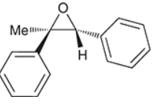
(a)
Interpretation: A starting material and reagents used to form following epoxide needs to be identified.

Concept introduction:
Preparation of epoxide-

Peroxy acids generally used in this process are MCPBA and peroxyacetic acid. Formation of epoxide via peroxy acid us a stereospecific process thus, cis substituents in alkene (starting material) remain at cis to each other in the epoxide (product). Similarly, trans substituents in alkene remain at trans to each other.
(b)
Interpretation: A starting material and reagents used to form following epoxide needs to be identified.

Concept introduction:
Preparation of epoxide- Epoxides can be prepared using peroxy acids. Alkenes are starting material in the preparation of epoxides with peroxy acids. Here, general reaction is represented as follows:

Peroxy acids generally used in this process are MCPBA and peroxyacetic acid. Formation of epoxide via peroxy acid us a stereospecific process thus, cis substituents in alkene (starting material) remain at cis to each other in the epoxide (product). Similarly, trans substituents in alkene remain at trans to each other.
(c)
Interpretation: A starting material and reagents used to form following epoxide needs to be identified.

Concept introduction:
Preparation of epoxide- Epoxides can be prepared using peroxy acids. Alkenes are starting material in the preparation of epoxides with peroxy acids. Here, general reaction is represented as follows:

Peroxy acids generally used in this process are MCPBA and peroxyacetic acid. Formation of epoxide via peroxy acid us a stereospecific process thus, cis substituents in alkene (starting material) remain at cis to each other in the epoxide (product). Similarly, trans substituents in alkene remain at trans to each other.
(d)
Interpretation: A starting material and reagents used to form following epoxide needs to be identified.

Concept introduction:
Preparation of epoxide- Epoxides can be prepared using peroxy acids. Alkenes are starting material in the preparation of epoxides with peroxy acids. Here, general reaction is represented as follows:

Peroxy acids generally used in this process are MCPBA and peroxyacetic acid. Formation of epoxide via peroxy acid us a stereospecific process thus, cis substituents in alkene (starting material) remain at cis to each other in the epoxide (product). Similarly, trans substituents in alkene remain at trans to each other.
Want to see the full answer?
Check out a sample textbook solution
Chapter 13 Solutions
ORGANIC CHEMISTRY (LL)-W/WILEYPLUS
- Assign the functional group bands on the IR spectra.arrow_forwardFind the pH of a 0.120 M solution of HNO2. Find the pH ignoring activity effects (i.e., the normal way). Find the pH in a solution of 0.050 M NaCl, including activityarrow_forwardPlease help me answer these three questions. Required info should be in data table.arrow_forward
- Draw the major organic substitution product or products for (2R,3S)-2-bromo-3-methylpentane reacting with the given nucleophile. Clearly drawn the stereochemistry, including a wedged bond, a dashed bond and two in-plane bonds at each stereogenic center. Omit any byproducts. Bri CH3CH2O- (conc.) Draw the major organic product or products.arrow_forwardTartaric acid (C4H6O6) is a diprotic weak acid. A sample of 875 mg tartaric acid are dissolved in 100 mL water and titrated with 0.994 M NaOH. How many mL of NaOH are needed to reach the first equivalence point? How many mL of NaOH are needed to reach the second equivalence point?arrow_forwardIncluding activity, calculate the solubility of Pb(IO3)2 in a matrix of 0.020 M Mg(NO3)2.arrow_forward
- Order the following series of compounds from highest to lowest reactivity to electrophilic aromatic substitution, explaining your answer: 2-nitrophenol, p-Toluidine, N-(4-methylphenyl)acetamide, 4-methylbenzonitrile, 4-(trifluoromethyl)benzonitrile.arrow_forwardOrdene la siguiente serie de compuestos de mayor a menor reactividad a la sustitución aromática electrofílica, explicando su respuesta: ácido bencenosulfónico, fluorobenceno, etilbenceno, clorobenceno, terc-butilbenceno, acetofenona.arrow_forwardCan I please get all final concentrations please!arrow_forward

 Organic ChemistryChemistryISBN:9781305580350Author:William H. Brown, Brent L. Iverson, Eric Anslyn, Christopher S. FootePublisher:Cengage Learning
Organic ChemistryChemistryISBN:9781305580350Author:William H. Brown, Brent L. Iverson, Eric Anslyn, Christopher S. FootePublisher:Cengage Learning

